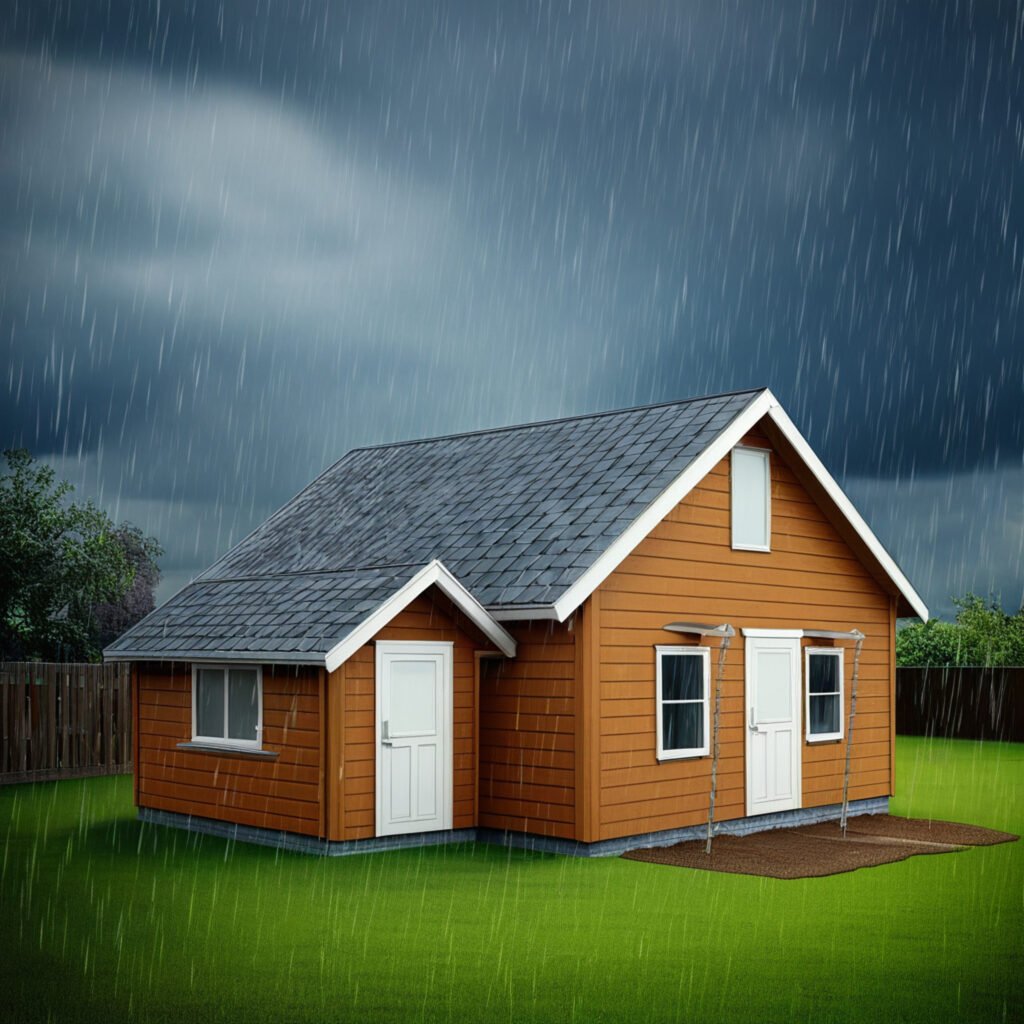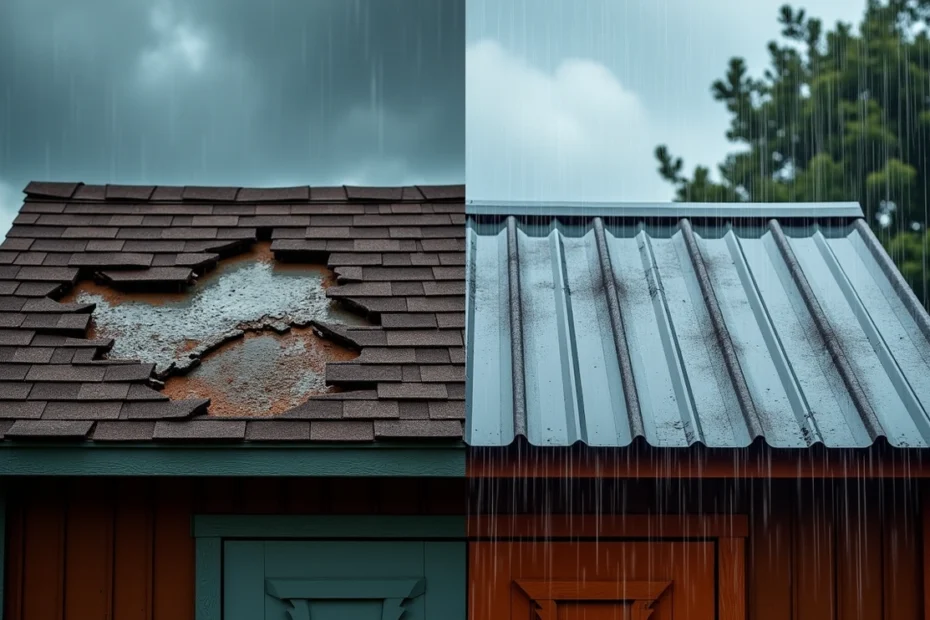The right shed roof designs can determine if your structure will collapse under winter snow or stand strong for decades. Properly constructed gable roofs prevent snow buildup with their steep pitch (typically between 20-45 degrees) and let heavy loads slide off easily. Many homeowners fail to consider critical design elements that could prevent their roof’s premature failure.
My years of evaluating shed roofs in different climates have shown that each type has its strengths with proper installation. Gambrel roofs, also known as barn roofs, give you excellent storage space and ventilation. A well-built hip roof can handle impressive wind speeds up to 140 mph. In this piece, we’ll get into common shed roof styles, explore the best materials for various weather conditions, and identify design flaws that make most shed roofs fail in harsh weather.
Why Most Shed Roofs Fail in Harsh Weather
“This means that with exposure to harsh winds or snow loads, weak trusses will bow or shift and can result in subtle problems such as a leaky roof or big problems like walls coming apart.” — Sunset Buildings, Professional shed and roof construction company with expertise in harsh weather durability
Weather extremes test shed roofs to their limits and expose design flaws we might miss otherwise. My inspection of hundreds of damaged structures revealed four critical failure points that can ruin even the best shed roof designs.
Poor pitch and slope design
The roof’s pitch (steepness) directly affects how well it handles water and snow. Most shed roofs fail because they’re too flat – roofs with less than a 2:12 pitch don’t deal very well with water runoff. Manufacturers of asphalt shingles usually need at least a 2:12 pitch, and areas with heavy precipitation need even steeper slopes. A roof that lacks proper slope puts too much stress on rafters and the whole structure as snow builds up.
Inadequate water drainage systems
Good drainage systems are the foundations of a long-lasting roof. Water adds 62.4 pounds per cubic foot and can quickly overwhelm a shed roof’s structural capacity. The best shed roofs need these drainage features:
- Positive drainage systems to stop water from pooling
- Clear paths for water to flow off the roof
- Right-sized drains or scuppers in the correct spots
Water sitting on your roof for more than 48 hours after rain shows you have drainage issues.
Lack of wind resistance features
Wind creates positive pressure on the windward sides and negative pressure (suction) above the roof. This mix gets more and thus encourages more uplift forces that can tear off roofing materials. Hip roofs handle high winds better because their four-sided design lets wind flow smoothly over the structure. The roof’s overhangs should stay under 20 inches to stop wind from using them as leverage points.
Improper ventilation and insulation
Shed roofs trap moisture without proper ventilation, which ruins structural components. Poor insulation creates temperature changes that damage roofing materials. In cold areas, bad ventilation helps form ice dams as heat leaks unevenly. The trapped moisture within the roof assembly leads to mold growth and rots the structure.
Small mistakes in shed roof design can mean big trouble during extreme weather. Your shed will stand up better to harsh conditions if you pay attention to these four key areas.
Shed Roof Types and Their Weak Points

Each shed roof type has weak points that show up during extreme weather. Building structures that withstand harsh conditions requires a good understanding of these weaknesses.
Gable roofs: snow and wind vulnerability
Gable roofs face their most important challenges in severe weather, despite being popular choices. Their vertical end walls become like sails in high winds and create pressure points that can damage the structure. These roofs are nowhere near as stable in areas with frequent strong winds. The uplift forces can loosen tiles, ridge caps, or structural elements when builders don’t reinforce them properly. The risks increase in snowy regions where the maximum snow depth can reach 1.5-2.0 meters in certain areas. The weight of accumulated snow puts tremendous stress on roofing systems that lack proper bracing.
Gambrel roofs: structural stress under load
Gambrel’s distinctive barn-style design creates extra interior space but brings structural vulnerabilities. Snow tends to pile up on the upper portion’s gentler slope and puts extra weight on the roof structure. The roof’s stability becomes compromised under high wind loads because it has more joints than simpler designs. Builders must use additional bracing or wind-resistant materials to prevent structural problems in storm-prone regions.
Saltbox roofs: asymmetry and balance issues
Saltbox roofs come with an asymmetrical design that features two uneven sides – one steep slope paired with a gradual incline. Complex framing angles and uneven load calculations result from this unbalanced distribution. The long back slope acts like a sail in windy conditions and needs extra structural support with additional rafters or hurricane ties. Homeowners just need creative interior design solutions because the irregular shape reduces the upstairs living space.
Hip roofs: complex construction flaws
Hip roofs are great at resisting wind, but their complex design creates numerous potential failure points. Builders must have precise measurements and advanced carpentry skills, which increases the chance of installation errors. The roof’s hips and valleys create complicated airflow patterns that make proper ventilation a challenge. These valves often leak if not installed and maintained correctly. Snow buildup in these areas can cause major damage when homeowners skip regular maintenance.
Shed Roof Materials That Don’t Hold Up
Your material selection for a shed roof can make or break its ability to handle harsh weather. The best structural design won’t help if you pick the wrong roofing materials – you’ll end up with early failures and costly repairs.
Asphalt shingles: short lifespan in extreme weather
Asphalt shingles are popular and budget-friendly, but they only last 15-20 years in perfect conditions. Areas with big temperature swings cut this lifespan even shorter. These shingles crack and turn brittle from constant heat changes, especially during quick hot-to-cold shifts. Strong sunlight speeds up the loss of protective granules, which leaves the base material open to water damage and wind destruction.
Wood shakes: moisture and rot problems
Wood shakes look great with their rustic charm but don’t hold up well in humid places. Untreated wood shakes soak up moisture and start to warp, split, and rot. This moisture creates perfect conditions for mold and mildew to grow, and the whole roof structure could fail. Wood shakes need regular care and preservative treatments to stay protective.
Metal panels: expansion and fastener issues
Metal roofing panels are tough, but extreme temperatures pose unique challenges. The metal expands and shrinks a lot with temperature changes, and this loosens the fasteners. Constant movement makes the screw holes bigger, letting water seep in. Salt spray near the coast makes fasteners rust faster, creating weak spots all over the roof.
Roll roofing: poor durability in storms
Roll roofing might be cheap, but it’s usually the first to fail in bad weather. Strong winds can tear this lightweight material, particularly where it’s joined or at the edges. Roll roofing works fine at first, but its thin design offers little protection against hail or falling branches.
Design and Build Mistakes to Avoid

The best shed roof designs can still fail if you overlook significant construction details. Most shed owners learn these lessons after weather damage gets pricey.
Ignoring local climate conditions
Your shed will likely fail if you build it without thinking about regional weather patterns. Steeper pitches let snow slide off naturally in snowy areas instead of piling up. Hip roofs give better protection in areas with high winds. Light-colored roofing materials work best in hot climates because they reflect heat.
Skipping overhangs and drip edges
A well-designed overhang keeps rainwater away from walls and foundation, which makes your shed last longer. Drip edges are metal flashings that go on roof edges and stop water from getting behind gutters. These protect your fascia boards and decking from rotting. Shingles need to stick out ¼ to ¾ inch past the drip edge for the best results.
Using the wrong fasteners or connectors
Fasteners often fail because people swap nails for screws without checking their shear strength. Standard galvanized fasteners don’t last long in coastal areas due to salt air corrosion. Stainless steel fasteners are worth the extra cost, even though they cost 2-3 times more.
Neglecting seasonal maintenance
You can catch small problems before they turn into expensive fixes with regular checks. We checked for loose shingles, blocked gutters, and foundation cracks in the fall. Spring is perfect for looking for water damage after winter.
Overlooking proper roof ventilation
Your shed’s interior will develop mold, wood rot, and tool damage if it lacks good ventilation. Ridge vents working together with soffit vents create the right airflow. This setup prevents moisture from damaging the structure.
Conclusion
A weather-resistant shed needs design elements that most homeowners don’t think about. As I wrote in this piece, most shed roofs fail in harsh weather due to poor pitch, bad drainage, weak wind resistance, and improper ventilation. Different roof styles like gable, gambrel, saltbox, and hip each have their own weak points that show up in extreme weather.
Design is crucial, and so are the materials. Asphalt shingles break down fast in extreme temperatures. Wood shakes have moisture problems, metal panels don’t deal very well with expansion, and roll roofing tears apart in storms. The best roof design and materials depend on your local climate.
Your shed’s lifespan will increase if you avoid common building mistakes. A resilient structure needs proper overhangs, the right fasteners, regular maintenance, and good ventilation. These small details often determine if your shed will collapse under winter snow or stay strong for decades.
Nature will always put our structures to the test. In spite of that, a well-laid-out and properly built shed roof can handle tough conditions if you focus on the key factors we covered. Smart planning now will help you avoid pricey repairs later. Your shed will stay reliable and functional, whatever Mother Nature throws at it.
